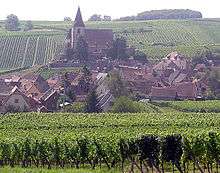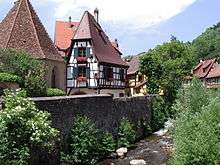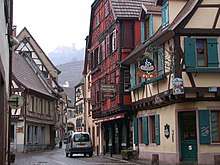Alsatian Vineyard Route
The Alsatian Vineyard Route (Route des Vins d'Alsace) is a mostly rural route in Alsace, France. The route stretches from Marlenheim in the north near Strasbourg, to Thann in the south and east to Mulhouse. The route goes along medieval wine producing villages situated on the slope of the Massif des Vosges.
- This article is an itinerary.

Regions
The route is officially divided into four regions: going from the South to the North, Thann-Colmar, Colmar-Ribeauville (Rappoltsweilen), Ribeauville-Obernai, Obernai-Marlenheim.
Towns and villages
.jpg)
The Alsatian Vineyard Route includes 67 towns and villages; their website has a map listing them all. The website also offers a brief description of suggested towns to visit.
The towns of Kaysersberg, Ribeauvillé, Riquewihr, Eguisheim, Turckheim and Bergheim are all close to Colmar, the latter having a large medieval city centre.
The villages of Eguisheim, Hunawihr and Riquewihr have the distinction of belonging to the association of Les Plus Beaux Villages de France (the most beautiful villages of France).
Other destinations
Nearby destinations are Strasbourg, Basel (Basle), Baden-Baden and the Black Forest. Do not miss Haut-Koenigsburg, a reconstructed medieval castle at the top of the mountains near Sélestat.
Talk
Since Alsace used to be entirely German speaking until WW II, Alsatian German is still common. The stocks of German tourists in the area also contribute to the fact that you can get along everywhere with German. French is the only official language and is spoken by everyone, apart from elderly people who still prefer to avoid it. English is usually only basically understood.
Get in
Since the Alsatian Vineyard Route is a rural area, accessibility with public transport is highly limited. If you drive a car you will find the signs very helpful guiding you to the next stop along the route. The roads are small though and not lit, so avoid traveling in the dusk if you can.
By train
Strasbourg and Colmar are along a main rail line between Paris and Basel. Although there is TGV service along this line, regional (TER) trains may be a better choice if travelling between Strasbourg and Basel as they are cheaper, not much slower and don't require reservations.
The medieval districts of Strasbourg and Colmar are within walking distance of the railway station.
Few of the small medieval towns are accessible by train. Turckheim has a number of TER (regional) trains per day from Colmar. The Turckheim station is just across the river from the old town.
Tourist taxi
An alternative to renting a car or to using public transit is to hire a tourist taxi (Voiture de tourisme avec chauffeur) at Colmar. The driver can easily take you to visit several of the medieval towns near Colmar allowing as much time as you wish to stroll each of them. (Most towns are very small and can be easily seen within 60-90 minutes.) A2T Alsace Transports Tourisme offers such a service. Some observations from a 2007 visit: The driver may speak only phrase-book English. If you understand French, the driver might offer some background on the sites, but is not required to do so. Have a list of towns you wish to see; suggestions are: Riquewihr, Ribeauvillé, Kaysersberg, Eguisheim, Turckheim, Bergheim. Let the driver choose the most efficient route. The number of towns you see depends on how much time you purchase and how long you linger in each town. It may be cheaper to purchase a block of time such a half or full day. The tourist office at Colmar might be able to help book a tourist taxi.
Get around
You can get around on foot within any town you visit.
See
All wine villages along the route are medieval and were almost perfectly preserved. They are normally tiny, which allows you to go through such a village in about half an hour. Bigger villages are Ribeauvillé, Riquewihr, Kaysersberg, Thann, Molsheim, Obernai, Barr and Guebwiller. Colmar is a small city and requires at least a half day.
Itineraries
You can tour the route for several days depending on how much of it you want to see. For one of the four regions specified above a day should normally suffice.
Do
Eat
Alsatian food: Sauerkraut, tarte flambée (flammeküche), Kugelhopf, Black Forest cake and macarons.
Drink
Try local Alsatian wine, which is excellent! Unusually for France, the wine labels prominently feature the grape variety. Riesling ages well and takes on a minerally, almost petrol flavor over time. Gewurztraminer is a wine you will love or hate. Floral, spicy, and perfumed, it is an ideal wine for spicy food such as curries. Pinot Gris is the French name for the now ubiquitous Pinot Grigio of Italy. Pinot Noir is the only red wine widely produced in Alsace.
Respect
Some of the locals might be offended if you refer to their small, medieval town as a "village" (village in French). Instead use the word "town" (or ville if you are speaking French) instead of "village". Apparently, the locals are proud that their town is sufficiently large or prominent to be called a "ville" (ville in French applies to both cities and towns). Ironically, the Alsatian medieval towns of Eguisheim, Hunawihr and Riquewihr belong to the association of Les Plus Beaux Villages de France (the most beautiful villages of France).
Stay safe
Don't drink and drive. The law regarding this is very strict in France - 0.25 mg of alcohol per litre of blood is the limit, which is so small you may as well write off driving altogether if you've had a glass of wine. Given the rural character of the area, you may be tempted to chance it on the assumption there'll be no police about, but that would be in ignorance of the Gendarmerie Nationale, whose specific job is to enforce the law in the countryside and on roads. This is not to mention the fact you'll be driving unfamiliar roads with foreign traffic rules and a language barrier to overcome, which is hard enough when sober. But slowing down is no hardship. Take your time, have lengthy stops at each town, spend a night and soak up the atmosphere. If you're really in a rush, make sure there's a designated driver who doesn't drink, or else book a local taxi to drive you around.

